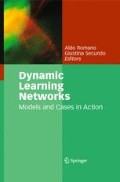Abstract
The shift towards the provision of integrated solutions, rather than standalone products or services, is increasingly important to the competitive success of leading companies worldwide. This model of industrial organization involves a customer-centric approach to business. Getting closer to the customer, deeply understanding its needs, and fulfilling them with “allinclusive” offers are essential capabilities of a solutions provider. Such a strategic trend entails a number of organizational changes affecting all the stakeholders involved, both internally and externally with suppliers and customers. As firms develop a new value proposition around, often beyond, their own traditional products or services, new capabilities are generated which reveal fundamental for establishing enduring and far more profitable relationships with customers. These changes offer opportunities of organizational learning, which firms can iteratively explore and exploit in order to gain sustainable competitive advantages.
Access this chapter
Tax calculation will be finalised at checkout
Purchases are for personal use only
Preview
Unable to display preview. Download preview PDF.
References
Auramo J, Ala-Risku T (2004) Challenges for going downstream. International Journal of Logistics: Research and Applications, 8 (4):333–345
Ballantyne D, Varey RJ (2006) Creating value-in-use through marketing interaction: the exchange logic of relating, communicating and knowing. Marketing Theory, 6 (3):335–48
Bessant J, Tidd J (2007) Innovation and entrepreneurship. John Wiley and Sons, Chichester
Ceci F, Prencipe A (2008) Configuring capabilities for integrated solutions: evidence from the IT sector. Industry and Innovation, 15 (3):227–296
Chesbrough H (2004) A failing grade for the innovation academy. Financial Times, September 24th
Cova B, Salle R (2000) Rituals in managing extrabusiness relationships in international project marketing: a conceptual framework. International Business Review, 9 (6):669–85
Davies A, Brady T (2000) Organisational capabilities and learning in complex product systems: toward repeatable solutions. Research Policy, 29:931–953
Davies A, Brady T, Hobday M (2006) Charting a path toward integrated solutions. MIT Sloan Management Review, 47 (3):39–48
Davies A, Brady T, Tang P (2003) Delivering integrated solution. Brighton: SPRU-CENTRIM, 1–34
Davies A, Brady T, Hobday M (2007) Organizing for solutions: systems seller vs. systems integrator. Industrial Marketing Management, 36:183–193
Davies A (2004) Moving base into high-value integrated solutions: a value stream approach. Industrial and Corporate Change, 13 (5):727–756
Davies A, Hobday M (2005) The business of projects: managing innovation in complex products and systems. Cambridge University Press, Cambridge
Galbraith JR (2002) Organizing to deliver solutions. Organizational Dynamics, 31 (2):194–207
Gummesson E (2006) Implementing the marketing concept: from service and value to lean consumption. In: “Invited commentaries on the service-dominant logic by participants in the Otago Forum”. Marketing Theory, 6 (3):289–98
Hobday M, Davies A, Prencipe A (2005) Systems integration: a core capability of the modern corporation. Industrial and Corporate Change, 14(6):1109–1143
Kalwani MU, Narayandas N (1995) Long-term manufacturer–supplier relationships: do they pay off for supplier firms? Journal of Marketing, 59:10–16
Middleton CJ (1967) How to set up a project organization. Harvard Business Review, March-April, 73–82
Miller D, Hope Q, Eisenstat R, Foote N, Galbraith J (2002) The problem of solutions: balancing clients and capabilities. Business Horizons, March-April, 3–12
Nonaka I, Takeuchi H (1995) The knowledge-creating company. Oxford University Press, New York
Pinto JK, Kharbanda OP (1995) Lessons for an accidental profession. Business Horizons, March/April, 41–50
Prencipe A (2003) The business of systems integration. Oxford University Press, Oxford.
Rust R (2004) If everything is service, why is this happening now, and what difference does it make? In “Invited commentaries on evolving to a new dominant logic for marketing”. Journal of Marketing, 68:23–24
Rust R (2006) Does the service-dominant logic need to go further? In “Invited commentaries on the service-dominant logic by participants in the Otago forum,” Marketing Theory, 6(3):289–98
Sandberg R, Werr A (2003) The three challenges of corporate consulting. MIT Sloan Management Review, Spring, 59–66
Tuli KR, Kohli AK, Bharadwaj SG (2007) Rethinking customer solutions: from product bundles to relational processes. Journal of Marketing 71:1–17
Vargo SL, Lusch RF (2004) Evolving to a new dominant logic for marketing. Journal of Marketing, 68:1–17
Wise R, Baumgartner P (1999) Go downstream: the new profit imperative in manufacturing. Harvard Business Review, 77, September-October, 133–141.
Author information
Authors and Affiliations
Corresponding author
Editor information
Editors and Affiliations
Rights and permissions
Copyright information
© 2009 Springer-Verlag US
About this chapter
Cite this chapter
Miraglia, S., Davies, A. (2009). Learning dynamics within the solutions network. In: Romano, A., Secundo, G. (eds) Dynamic Learning Networks. Springer, Boston, MA. https://doi.org/10.1007/978-1-4419-0251-1_5
Download citation
DOI: https://doi.org/10.1007/978-1-4419-0251-1_5
Published:
Publisher Name: Springer, Boston, MA
Print ISBN: 978-1-4419-0250-4
Online ISBN: 978-1-4419-0251-1
eBook Packages: Computer ScienceComputer Science (R0)

